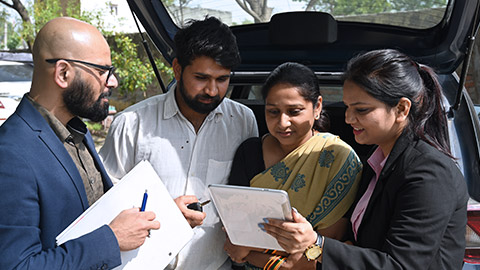Communication is a fundamental aspect of workplace activities and is generally considered an enabler that contributes to the achievement of business objectives and successful outcomes.
Communication involves the sending and receiving of a message from a sender to a receiver in a way which is free of interference and includes feedback. Feedback is used to provide information to the sender about whether the message has been received and understood by the receiver. Interference refers to factors which can inhibit the successful transmission of the message, such as background noise, distractions or language barriers.
Activity
Prepare a short message that you can communicate to another person. Deliver the message in two ways – once with no background noise and once with music playing in the background. Compare how effectively the message is able to be communicated in both situations. Does the music playing make a difference to how well the message is able to be shared with the receiver?
Communication can include verbal and non-verbal types.
| Verbal | Non-verbal |
|---|---|
| Verbal communication includes spoken language, as well as augmentative and assisted forms of communication, such as the use of a communication device or board, or Auslan interpreting. | Non verbal communication includes gesture, pointing, body position, tone of voice and voice pitch. |
Verbal and non-verbal communication combine to form the message which moves from the sender to the receiver.
Activity
Visit Yooralla’s COMTEC website and find and download a copy of the referral form.
This form is used to access support for a client who needs support for communication technology or strategies.
Greetings, closings and signs of respect
People use many different types of greetings and closings during communication exchanges. They also show respect for each other in different ways. Sometimes this is based on culture and sometimes it is a reflection of what has been learnt in other situations over time. Greetings and closings can include:
- Nod
- Handshake
- Smile
- Touch of the shoulder
- Bow
- Hug
- Pat on the back
- Eye contact
Signs of respect can include:
- Not using direct eye contact
- Using terms such as ‘Aunty’ or ‘Uncle’
- Asking someone to leave a room or enter a room for a discussion
- Respecting times where a certain person is or is not permitted to be a part of a conversation or in the presence of another person
- Using a chaperone
- sing gestures and action
- Not touching particular parts of the body, such as the head
- Not pointing particular parts of the body towards another person, such as the soles of the feet
Example
Some Aboriginal or Torres Strait Islander people may ask a person to leave the room so family or private business can be discussed. You are being respectful if you honour this request.
Questions
- How do you greet someone new?
- Do you greet different people in different ways?
- How have you learnt the greetings and closings that you use?
Cultural variations
People communicate in very different ways and sometimes these differences are based on their culture. Avoid stereotypes and assumptions though, because not all people from a single cultural background will communicate in the same way.
Differences which may be based in culture can include:
Many people think that particular communication styles go with a single culture, such as assuming that all people who are Japanese will bow as a greeting and all people who are Vietnamese will avoid eye contact with an authority figure. While this is true for some people, don’t this will be the case for every Japanese or Vietnamese person that you meet. Learn about individual communication needs and preferences for each person you meet.
Purpose of communication
People communicate for many different reasons and in many different ways.
Communication is vital for:
- Sharing information
- Building a trusting relationship
- Providing direct support and care
- Finding out more about needs and preferences
- Receiving information from a client or family member
Think about the purpose of your communication before you begin each interaction. Ask yourself:
Who am I communicating with?
What are their communication needs?
What is the message?.
Remember that sometimes it is just as important to listen actively as it is to speak or respond. Listening and speaking are both important parts of verbal communication.
Barriers to communication
Sometimesthere will be communication barriers that you need to manage..
Some potential barriers to communication could include:
- People who do not share a common language
- People who do not have written language skills
- People who cannot read printed text
- The presence of a sensory impairment (vision or hearing loss)
- Power imbalance between the people involved
- A noisy environment
- Distractions
Barriers to communication can occur in many different situations. Communication with clients can often involve barriers, particularly if the person is from a cultural or linguistic background which is different to your own or if they have multiple barriers such as being homeless, having a mental health condition or disability, being a refugee or asylum seeker, or having experienced trauma.
Strategies to manage barriers to communication
There are several steps you can use to manage barriers to communication. These are:
- Identify the barrier
- Plan the communication
- Evaluate effectiveness
Practical approaches can include:
- Using shorter sentences
- Simplifying complex ideas and expressions
- Making a visual or graphic based version of information (e.g. infographics or charts)
- Increasing white space or quiet space (where no words are used)
- Attending to body language
- Changing tone of voice and voice pitch
- Defining jargon or unusual terms that might not be understood
- Responding appropriately to behaviours
The best approach will vary depending on the situation and the communication barrier. Think about the barrier and how it might affect your communication exchange, then plan how to use an appropriate strategy. When you have finished communicating with the person, reflect on the effectiveness of the approach. What went well? What could you improve on? Write your ideas in your reflection journal.
Key Word Sign
Some people use Key Word Sign as a way of communicating with others. This is a modified version of Auslan where only the most important words are signed. It is useful to learn some basic Key Word Signs if you work in community services – they are a great way of communicating with people who have a communication need.
Watch this video to learn more about Key Word Sign:
Distractions
Sometimes distractions can make it harder to communicate. Distractions can be movement of people or objects, wind, noise or computers or TVs. Removing distractions can make communication easier for many clients.
Case study

Max is communicating with a young person who is on the autism spectrum. He knows the person has a short attention span and tends to become distracted easily during a conversation. They have had several meetings prior to this one, and each time, Max has found the conversation lasted for around ten minutes before the young man became bored and inattentive and distracted by people walking past their meeting room. Today, Max decides to hold the appointment in a quiet space with softer furnishings and dimmer lights. He changes his tone of voice so it is quieter and lower, and gives the young man a printed copy of the information he wants to discuss with him, written in Plain English writing style. He times their conversation and pays attention to how quickly the young man becomes distracted. When Max reflects on the conversation, he is pleased that the change of location and approach has resulted in a much longer discussion and improved attentiveness for the young man.
Questions
- What do you know about the communication needs of people who are on the autism spectrum?
- How could you change your communication style to suit their specific needs in a meeting or appointment?
Behaviour as communication
Behaviour is really just another way that people communicate with each other. Sometimes people aren’t able to communicate their ideas and emotions through written or spoken language, and so may use other behaviours to communicate instead. They might call out, shout, hit, pinch or run away as a way of expressing what they are thinking or feeling. Although this might not be the most appropriate way of communicating, it is perhaps the most effective way the person has to communicate with you.
You can think about whether the behaviour is because of:
- Lack of spoken language
- Frustration
- Boredom
- Previous attempts at communication that no one noticed
- Not being responded to
There are many reasons people can use behaviour as a type of communication.
Concept
People who have experienced trauma can sometimes have a heightened response to situations and may appear to overreact. This is caused by being hyper-vigilant. Triggers such as a loud noise, a feeling of being threatened or a communication exchange that is not expected can prompt an extreme response.
Examples of behaviour as communication which may be seen in community services settings include:
Activity
Look at each of the people in the below table. Think about how and why they might respond in the way they are – consider a possible reason that might lie behind their communication response. Describe the type of communication they are using and then plan how you might respond to the situation.
Example

Sandi visits a day setting for adults who have a cognitive disability, to give a presentation about NDIS options. She dresses formally and brings her information on a USB stick, ready to load onto a data projector. She prepares written handouts to give to the audience and places a copy on each seat before she begins. She introduces herself and then speaks for about ten minutes, before asking her audience to turn to a particular page in the notes she has given them. It is then that Sandi realises her audience are mostly unable to read the notes and that they are not understanding her presentation. Some of the audience members stand up and walk out of the room, assuming she has finished. Others look at her and wait for more information. Sandi thinks about the situation and realises that she has not considered the needs of her audience before she prepared her presentation. Her communication has been inappropriate, ineffective and disrespectful of their communication needs.
Respectful communication
Communication involves more than simply passing a message from one person the other. Communication is also an important part of how we build relationships. Take your time when you communicate with someone so you can make sure you are being respectful.
Plan what you are going to say and do before you begin. Think about the person and their needs. You may need to adapt your communication style to suit the needs of the person. You will need to know a little bit about the person and their communication preferences.
You can learn about a person by:
- talking to them
- reading notes in their case file
- observing their body language
- talking to other workers
- asking the person to tell you about their communication preferences
- thinking about their previous experiences.
Consider your own role in a communication exchange, as the way you communicate and the importance of trust and rapport will be different in each situation.
Respectful communication with specific groups of people
Some groups of people experience discrimination more often than others in our community. The use of respectful and appropriate communication helps reduce the harm experienced as a result of discrimination. People who identify as lesbian, gay, bisexual, transgender, intersex (LGBTI) or queer are more likely to experience discrimination. Research tells us there is a clear link between these experiences and the incidence of anxiety and depression. Respectful communication is one strategy that can reduce the harmful effects of anxiety and depression for this group of people in our community.
Respectful communication with people from Aboriginal or Torres Strait Islander cultures may mean:
- Being discreet
- Respecting that some information or discussion might relate to Men’s or Women’s business
- Taking a roundabout approach to questioning
- Building a relationship with the person first
- Understanding that ‘yes’ sometimes means ‘I have heard you’ rather than ‘I have understood you’
- Avoiding using greetings of ‘Aunty’ or ‘Uncle’ unless it is appropriate for you to do so
- Understanding that shame may be associated with sharing private or confidential information with another person
There are several types of professionals who can assist with communication and help overcome barriers. These include interpreters, translators and training and support services. Interpreters and translators can provide assistance in overcoming barriers to written and verbal communication. Training and support services can help workers and work teams learn to do their jobs more effectively.
Interpreters
Interpreters are qualified people who speak in more than one language. Interpreters can work in a face to face situation or provide services over the phone. Interpreters listen to a conversation and repeat exactly what has been said by each person, so that the other person is able to understand. Interpreters do not change the meaning of verbal communication and they do not play any role in the actual conversation. Their role is only to repeat the words spoken in the alternate language so it can be understood. You should avoid using interpreters from within the family, particularly if the topic is challenging, personal or confidential. Although family members can often speak the same language as a client, they are not always the best choice for interpreting in situations where confidentiality is important.
Example

Greta is working with a client to secure safe emergency housing. The client has recently left her family home as she fears being taken back to India for a forced marriage to someone she has never met. She speaks limited English and is fluent in Hindi. The woman’s brother has offered to translate their conversation, but Greta does not believe he will translate accurately or reliably. Greta works quickly to arrange a professional interpreter instead. During their conversation, Greta learns that the brother was involved in organising the forced marriage and had planned on deliberately misinterpreting the conversation to make Greta believe the woman really did want to move back to India to get married.
Some interpreters use a form of signing called Auslan. This is the language of the Australian deaf community. Auslan interpreters use hand gestures and facial expression to interpret and provide meaning to the other person in a conversation with someone who is hearing impaired
Watch
Go online and visit the website for Auslan Services. Watch the short video to learn more about Auslan interpreting.
Translators
Translators are people who are able to read and write in more than one language. They perform tasks to convert written text from one language into another. Translators can write different language versions of documents. You could use a translator for:
- service guidelines
- case notes
- plans
- application forms
- agreements
- letters
- referrals.
It is important that clients are able to understand the documents you share with them. People cannot sign or agree to services or plans that they cannot read and understand.
Research
Visit the website for TIS and learn about the interpreting and translating services available for not for profit organisations.
Training and support services
You can do face to face or online training. This can include learning about:
- Building knowledge about indigenous cultures
- Learning about how to improve a program
- Mastering better verbal and written communication with clients
- Discovering how to match your communication to the needs of your client
Training and support services may be offered in the workplace as part of a professional development program, or off site as part of a conference, training event or customised solution.
Research
Imagine you are working for mental health services provider that wants to increase reach and effective engagement with people from Aboriginal and Torres Strait Islander communities. Go online and develop a ‘top three’ list of possible training and support services that could be suitable. Write a list of pros and cons for each one to help you decide which you would recommend and why.
Now it's your turn
- What are two ways of communicating with a person who is hearing impaired?
- How could you use imagery as a way to communicate?
- Why is non-verbal communication just as important as verbal communication?

